Before I tell you about the fun we had this weekend, I want to mention that I’m teaching two upcoming classes for Travis Audubon. The first is “Creating a Wildlife-Friendly Native Garden,” on October 13. This 3-hour class will take an in-depth look at wildlife gardening, from great native plants to design considerations to fun projects, and more. The next week, on October 20, I’m teaching a class geared toward kids: “Family Fun with Wildlife Gardening.” Designed for kids ages 4-11, along with their parents or grandparents, we’ll have fun taking a look at the different kinds of wildlife that you can attract to your backyard, understanding how native plants are connected to native wildlife, and making a gift for wildlife that every child can bring home to their own garden. Both classes have size limits, so please register soon and join us!
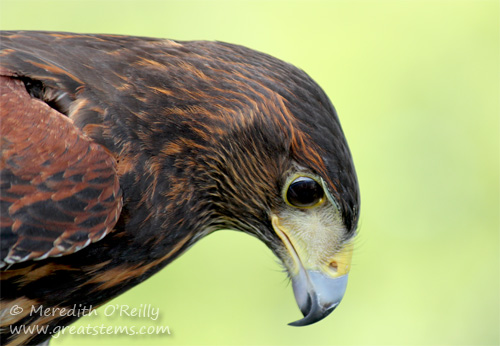 This weekend the boys and I drove down to Hazel Bazemore Park in Corpus Christi, where hundreds of thousands of hawks and other birds can be seen during peak migration times, especially in the fall. Though fall migration occurs over several weeks, at the end of September local birding groups hold the Corpus Christi Hawkwatch as a focused celebration. (note: above is a Harris’s Hawk)
This weekend the boys and I drove down to Hazel Bazemore Park in Corpus Christi, where hundreds of thousands of hawks and other birds can be seen during peak migration times, especially in the fall. Though fall migration occurs over several weeks, at the end of September local birding groups hold the Corpus Christi Hawkwatch as a focused celebration. (note: above is a Harris’s Hawk)
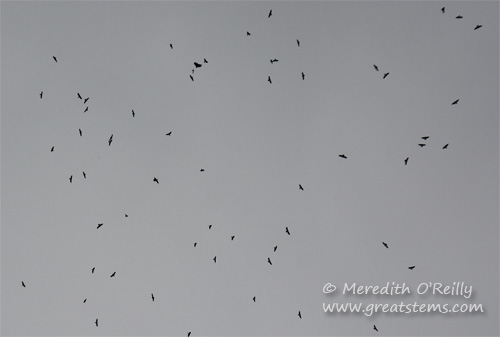 The biggest numbers are usually of Broad-Winged Hawks, though we saw many other raptor species while we were there, including a Zone-tailed Hawk, White-tailed Hawks, and many Kites, Kestrels, and Peregrine Falcons. Due to the heavy rainstorms the day before, however, the numbers weren’t quite as high as might otherwise have been seen — merely thousands as opposed to hundreds of thousands in the overall count.
The biggest numbers are usually of Broad-Winged Hawks, though we saw many other raptor species while we were there, including a Zone-tailed Hawk, White-tailed Hawks, and many Kites, Kestrels, and Peregrine Falcons. Due to the heavy rainstorms the day before, however, the numbers weren’t quite as high as might otherwise have been seen — merely thousands as opposed to hundreds of thousands in the overall count.
The photo above shows a typical kettle of Broad-winged Hawks, but I had to zoom in and crop out a lot of birds to show you something more than just dots in the sky. They swirl and soar as they catch thermals to help them move ahead on their journey.
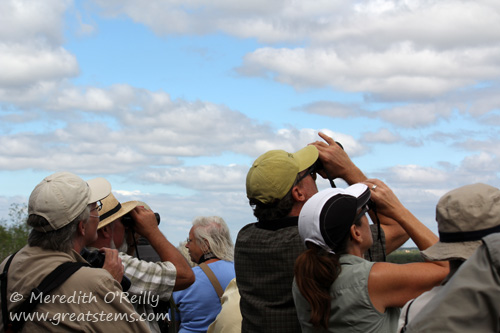
Those watching with binoculars and scopes worked together to call out the birds they sighted. I was no help. I’m too much a novice at IDing hawks from a distance, but that’s one reason I wanted to go down to be with others who know their stuff. Of course, my boys had both of our binoculars, and all I had to work with was my zoom lens, but that’s okay, too.
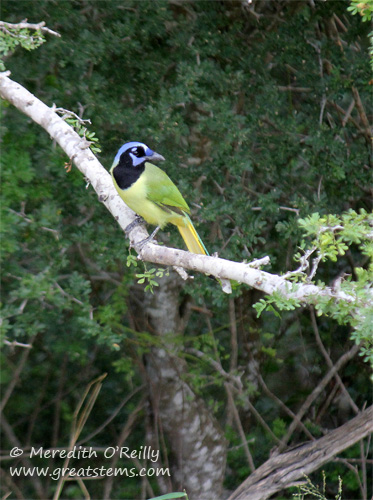 Mine is not a massive zoom lens, mind you, so my hawk pictures are few. However, a stroll around the park let me snap some photos of other birds in the area. Above is a gorgeous Green Jay.
Mine is not a massive zoom lens, mind you, so my hawk pictures are few. However, a stroll around the park let me snap some photos of other birds in the area. Above is a gorgeous Green Jay.
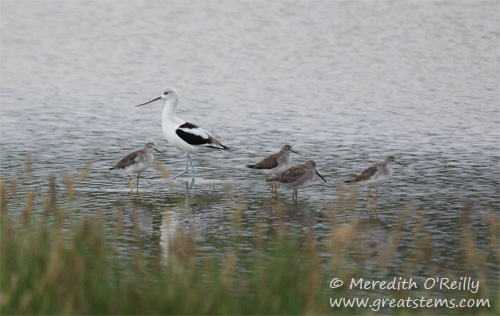 One reason Hazel Bazemore is such a top birding spot in the Corpus area is that it offers a variety of habitats to please many different bird species, including shorebirds, as well as birds that prefer denser vegetation.
One reason Hazel Bazemore is such a top birding spot in the Corpus area is that it offers a variety of habitats to please many different bird species, including shorebirds, as well as birds that prefer denser vegetation.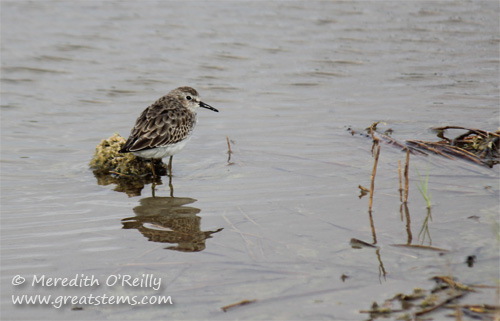
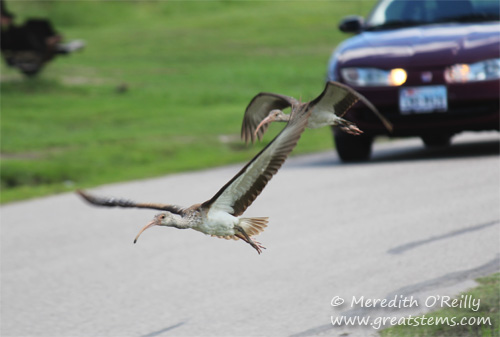
These Ibises couldn’t make up their mind where they wanted to look for food and kept flying here and there and back again.
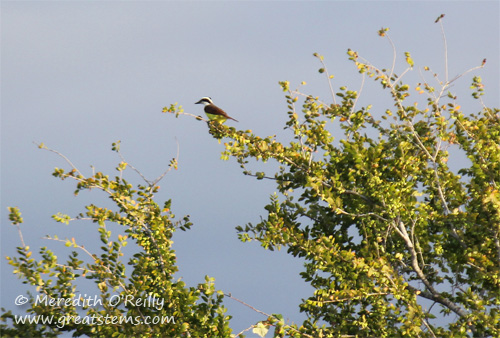
A Great Kiskadee is commonly seen in Corpus Christi, but it was a new bird for me and the boys. It has quite the personality.
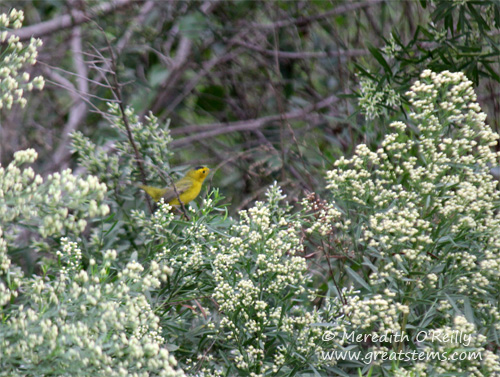
This Wilson’s Warbler was tough to catch a glimpse of, and even tougher to get a picture of!
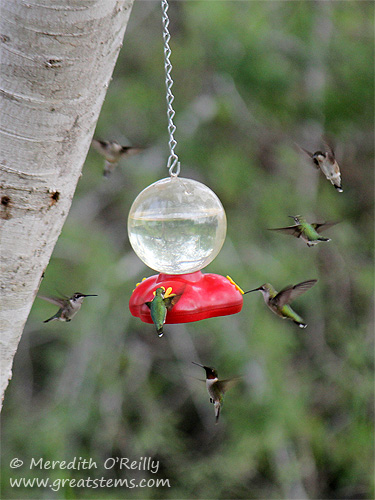
Of course, Corpus Christi birding in the fall wouldn’t be complete without lots and lots of Ruby-throated Hummingbirds.
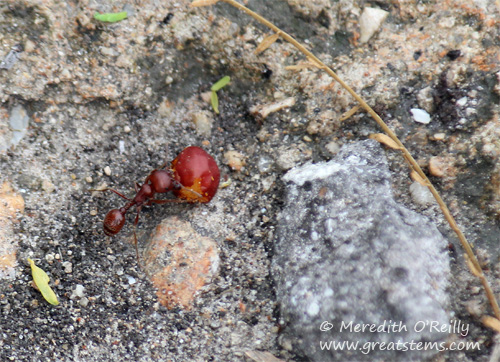
Looking down instead of to the sky, more wildlife was busy at work, including termite trails, which were fascinating. My son was most impressed with this ant’s ability to carry a relatively huge berry across a relatively huge distance.
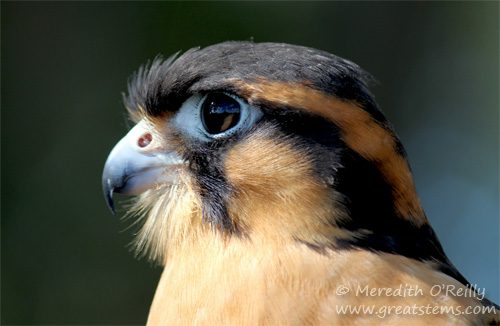
As part of the Hawkwatch celebration, a falconer brought some birds out for show and tell (this includes the Harris’s Hawk at the top of the post, though Harris’s Hawks are occasionally spotted at Hazelmore each fall). Above is a captive-bred Aplomado Falcon, rare to spot in the wild but can be found in southwest Texas, Mexico, and farther south.
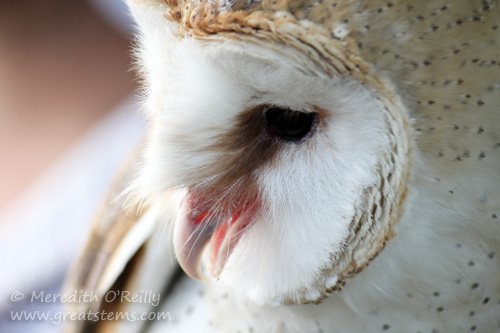 A European Barn Owl bears quite the resemblance to our native variety but is a bit smaller.
A European Barn Owl bears quite the resemblance to our native variety but is a bit smaller.
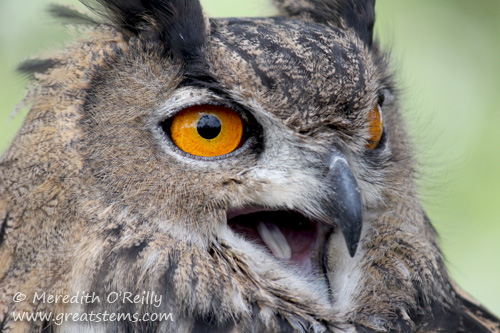 Here’s an Eagle Owl, which bears a resemblance to our Great Horned Owl but is actually native to Eurasia. It’s also larger than a Great Horned Owl. Gorgeous, it is.
Here’s an Eagle Owl, which bears a resemblance to our Great Horned Owl but is actually native to Eurasia. It’s also larger than a Great Horned Owl. Gorgeous, it is.
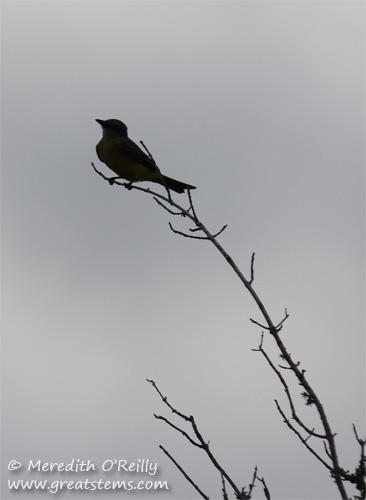
Sometimes you’ve just got to end with a silhouette. That’s a Couch’s Kingbird above, showing off its classic bird shape.
FYI, it’s not too late to go see hawks down in Corpus Christi — they’ll continuing migrating throughout October. We hope to return to Hawkwatch next year — it’s so nice to be surrounded by lots of birders who can confirm identification, especially when the hawks are so high in the sky. Fun, fun, fun!
P.S. Thanks to my father-in-law for joining us! We were our own little flock of birders this weekend.
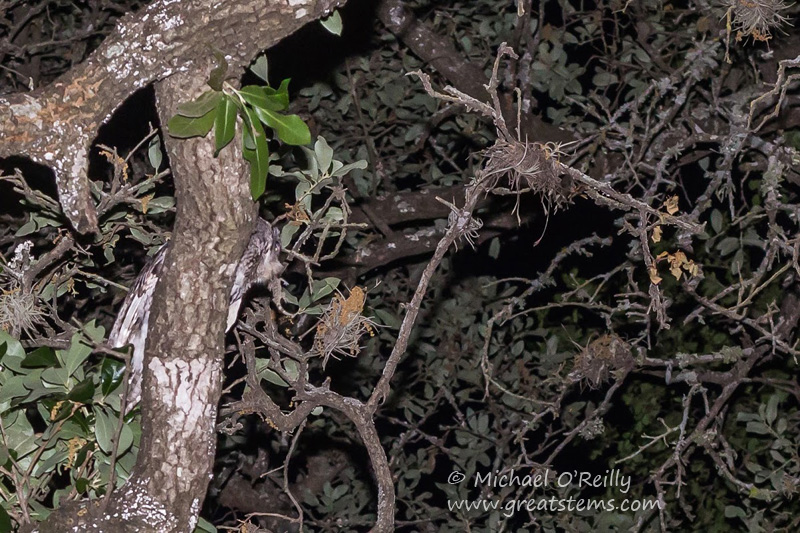
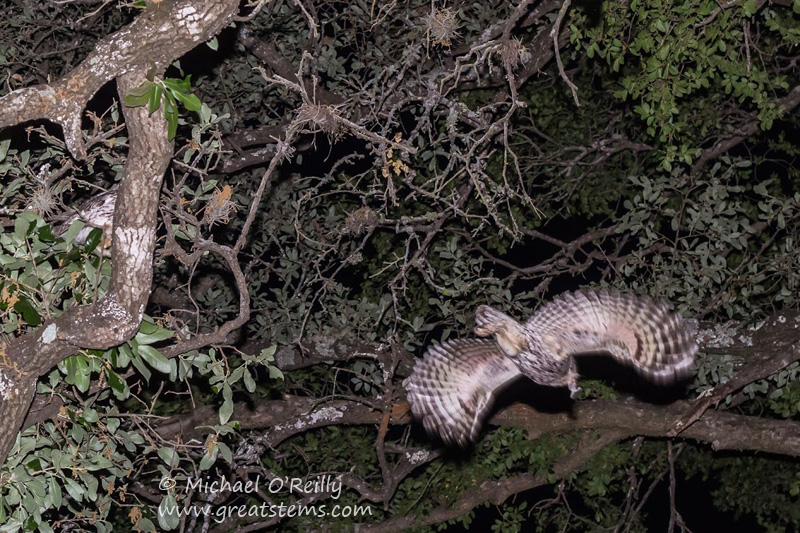
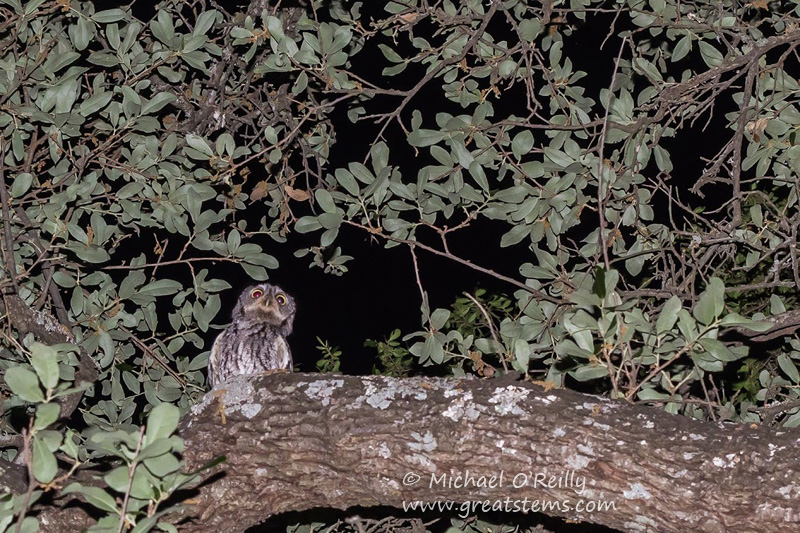
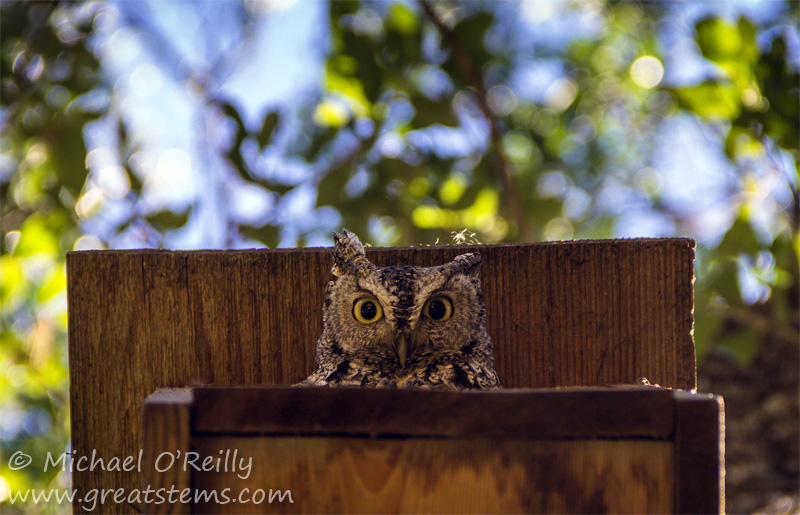
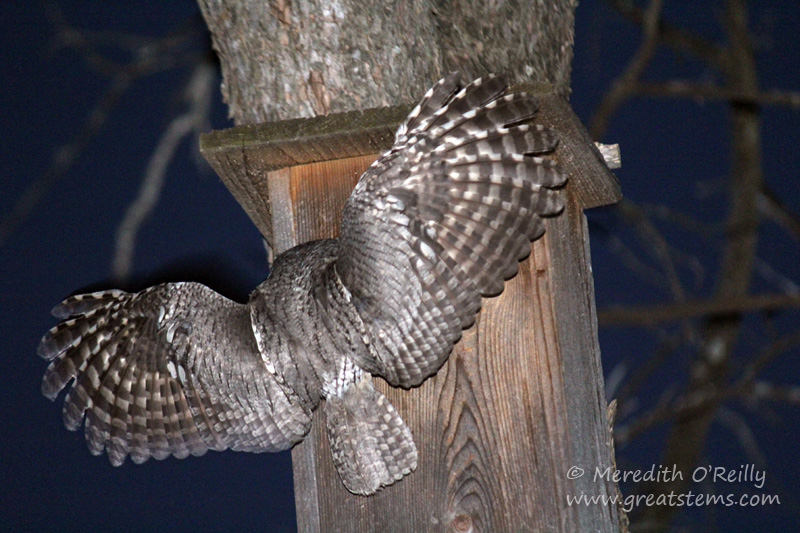
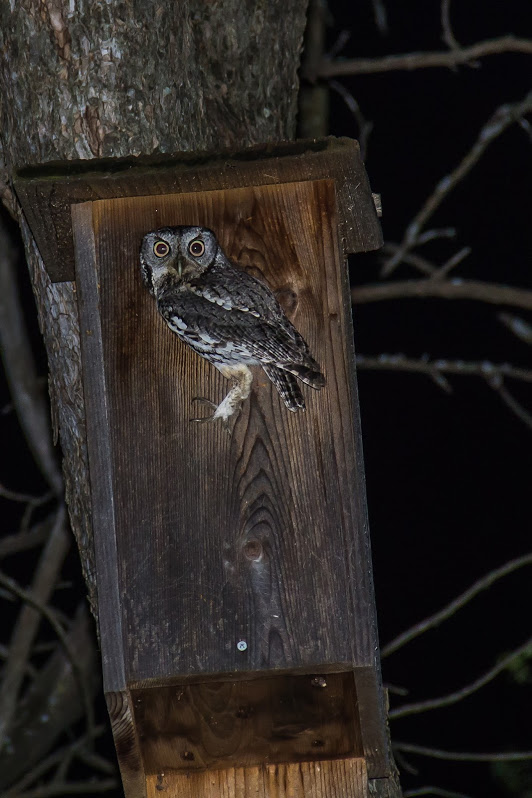
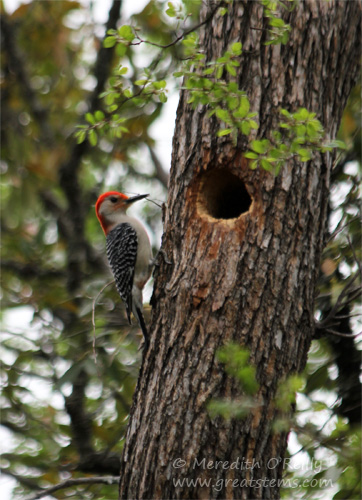 Here is the male. He frequents our birdfeeder, which we keep amply supplied with peanuts for him. Well, he does have to share with other visiting woodpeckers, blue jays, and other feathered friends who also love peanuts. That was the deal we made.
Here is the male. He frequents our birdfeeder, which we keep amply supplied with peanuts for him. Well, he does have to share with other visiting woodpeckers, blue jays, and other feathered friends who also love peanuts. That was the deal we made.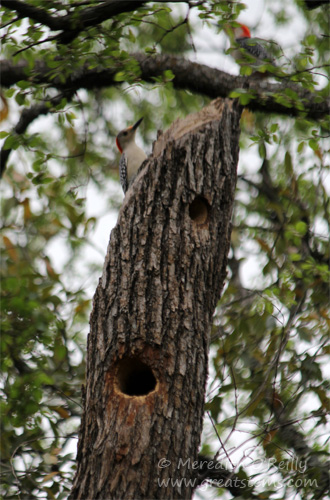
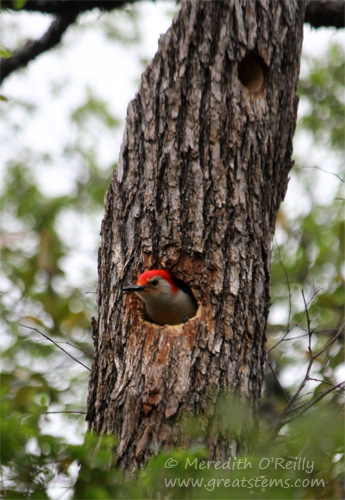 It’s hard to tell whether the birds are actually nesting right now or still excavating their cavity, but if the latter, they’ve been working on it a long time. I do know they are working hard.
It’s hard to tell whether the birds are actually nesting right now or still excavating their cavity, but if the latter, they’ve been working on it a long time. I do know they are working hard.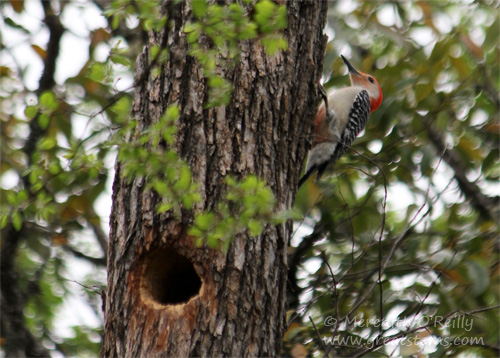
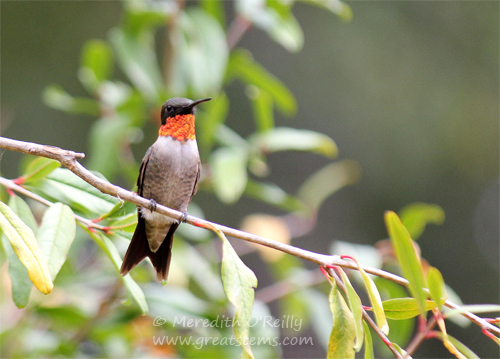
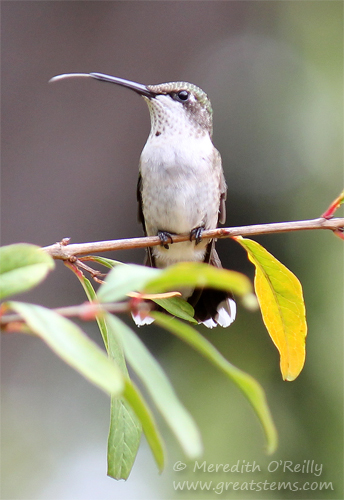
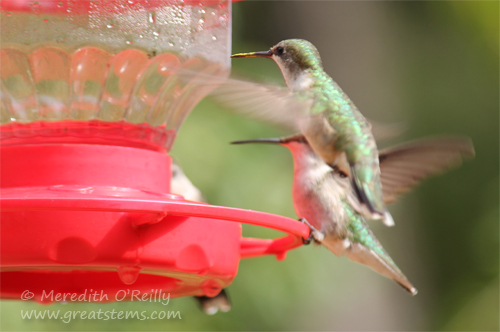
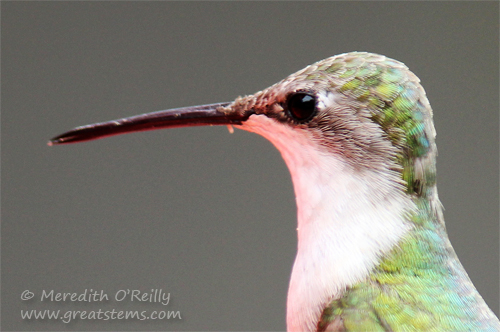
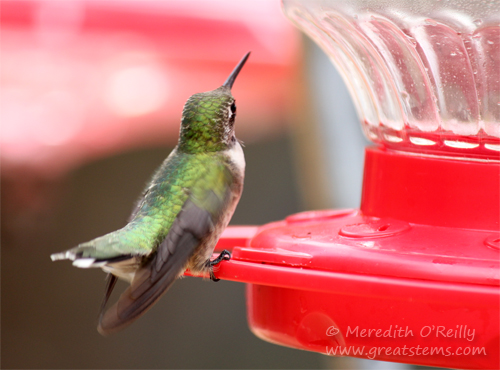
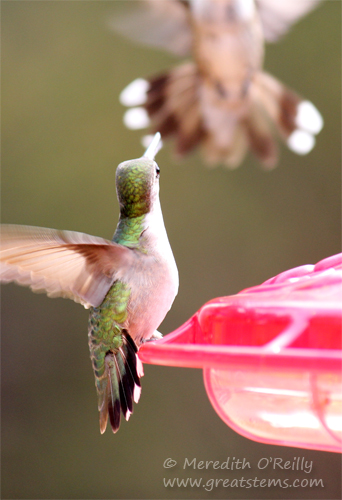
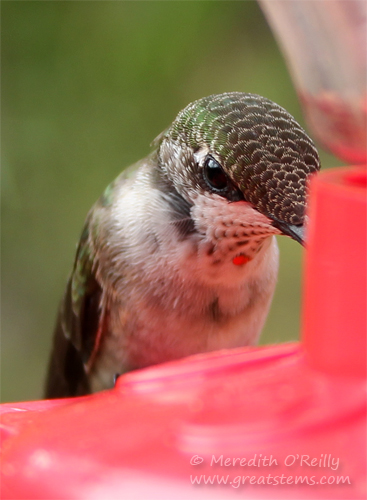
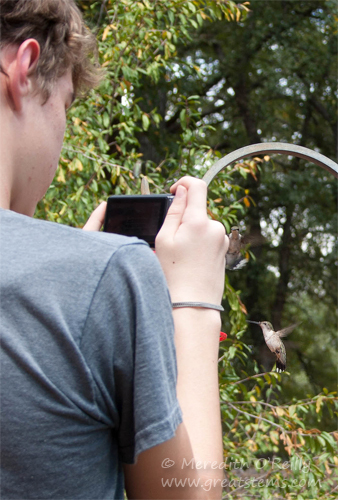
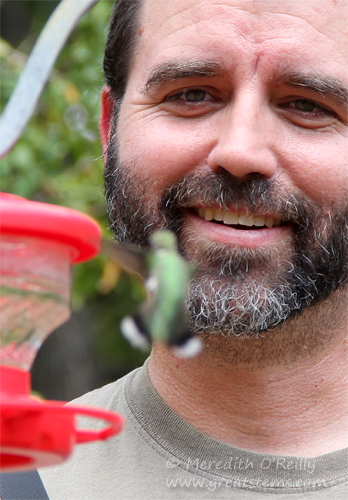
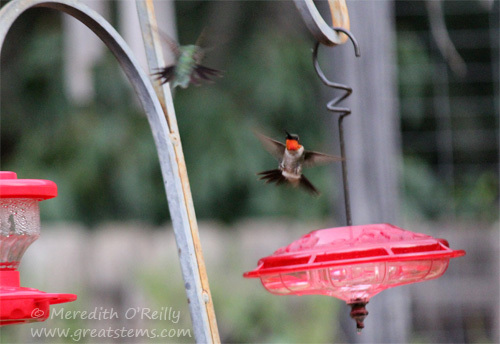 The sounds of the feisty little birds draw me outside. The hummingbirds are usually so focused on defense and territoriality and getting nectar that they hardly noticed the humans taking pictures, dogs running amok, and thunder or other noises in the background. Such was this evening’s setting.
The sounds of the feisty little birds draw me outside. The hummingbirds are usually so focused on defense and territoriality and getting nectar that they hardly noticed the humans taking pictures, dogs running amok, and thunder or other noises in the background. Such was this evening’s setting.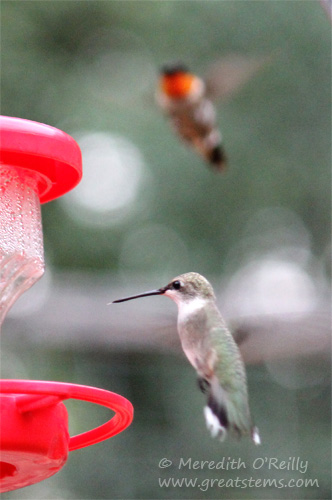
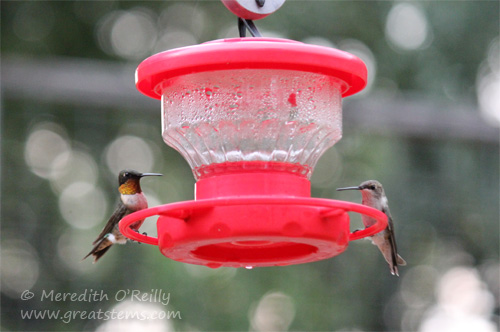 Occasionally hummingbirds will settle down and share a feeder. In fact, as more hummers appear during migration, they will share more and more, as the need to build up energy stores for long-distance travel becomes more pressing.
Occasionally hummingbirds will settle down and share a feeder. In fact, as more hummers appear during migration, they will share more and more, as the need to build up energy stores for long-distance travel becomes more pressing.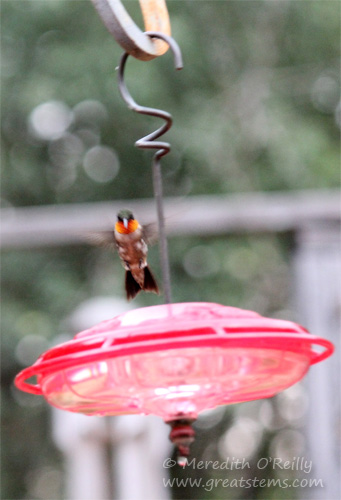 During migration season, the vast majority of the hummingbirds I see in my Austin garden are Ruby-throats. The males have the iridescent gorget, which seems truly vibrant when the light is just right (but otherwise it looks dark).
During migration season, the vast majority of the hummingbirds I see in my Austin garden are Ruby-throats. The males have the iridescent gorget, which seems truly vibrant when the light is just right (but otherwise it looks dark).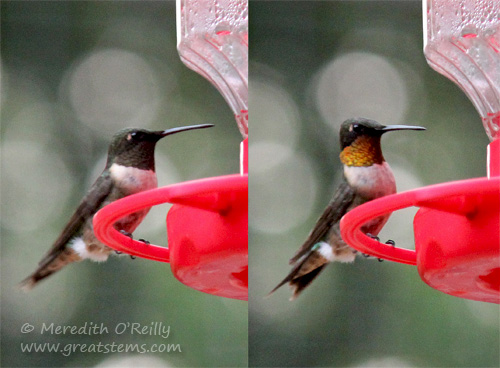
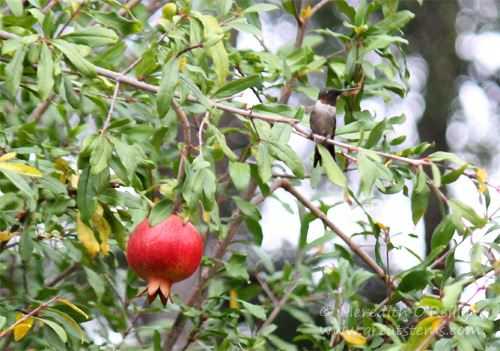
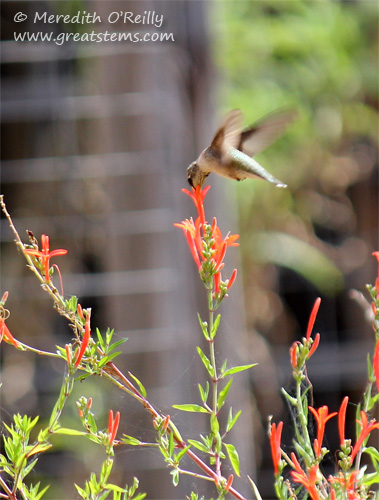
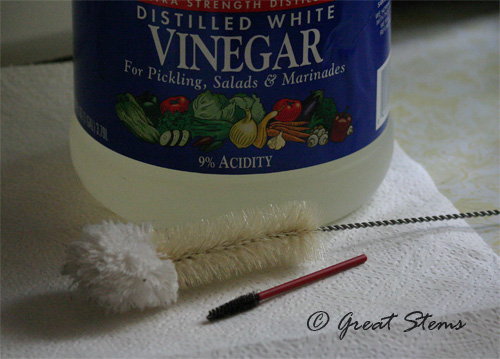
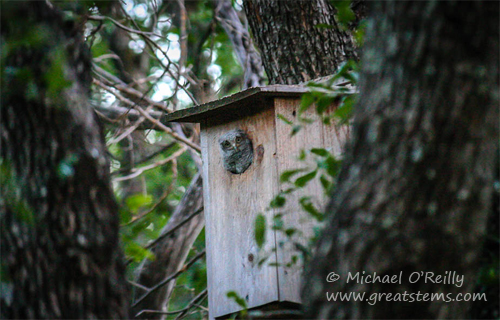 Taking pictures of owlets is an interesting process. We have to be very careful to start by taking pictures far across the yard, in case they get skittish and disappear as we approach. We also have to be fast but discreet as we take pictures, and we just have to hope they don’t come out blurry. As the sun goes down, we’re challenged by the decreasing available light, and then comes full darkness. All the while, you can’t move very quickly, or the owls will hide themselves away in a flash.
Taking pictures of owlets is an interesting process. We have to be very careful to start by taking pictures far across the yard, in case they get skittish and disappear as we approach. We also have to be fast but discreet as we take pictures, and we just have to hope they don’t come out blurry. As the sun goes down, we’re challenged by the decreasing available light, and then comes full darkness. All the while, you can’t move very quickly, or the owls will hide themselves away in a flash.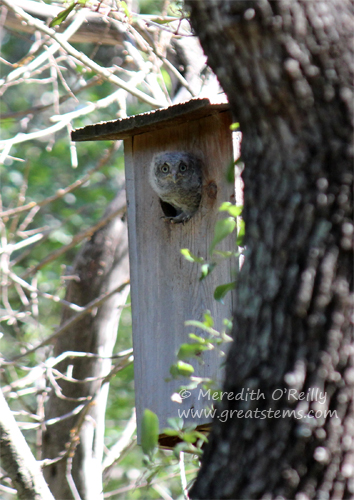
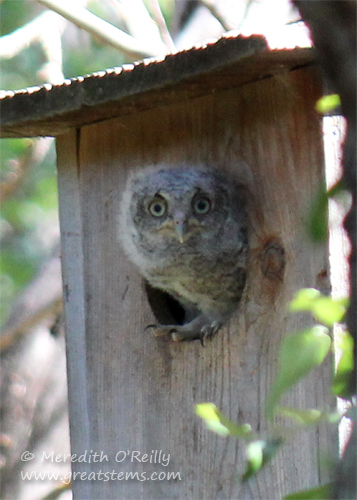
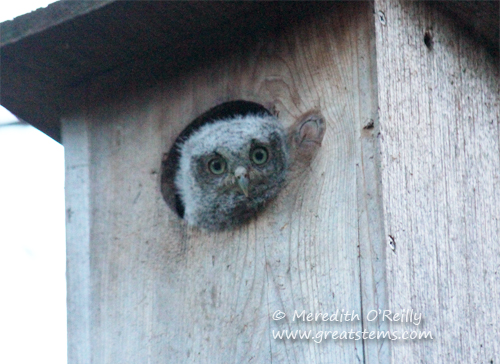 At this point in the photo sequence, you can see that the sun is going down. After a late afternoon nap, one of the owlets peeked out to start looking for mama. Its eyes would track everything that moved — birds, bugs, dogs, and us.
At this point in the photo sequence, you can see that the sun is going down. After a late afternoon nap, one of the owlets peeked out to start looking for mama. Its eyes would track everything that moved — birds, bugs, dogs, and us.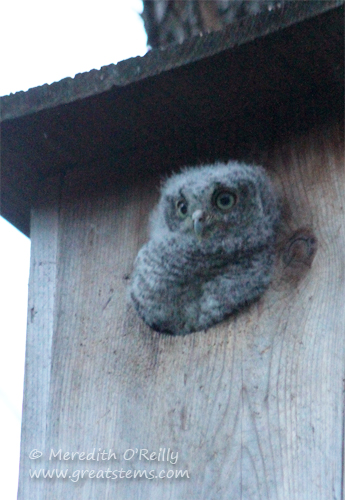
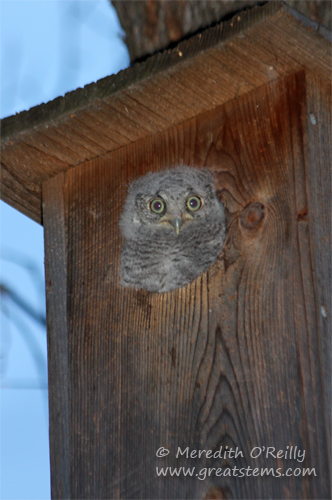
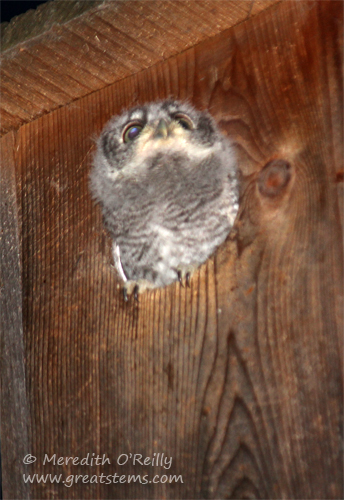
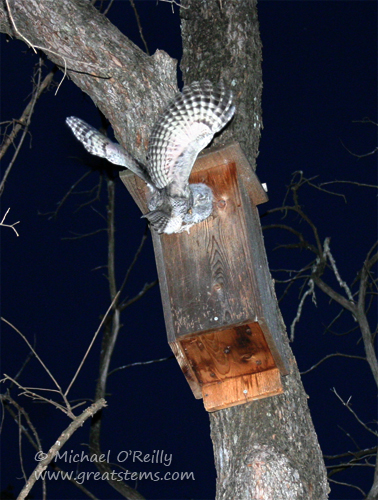
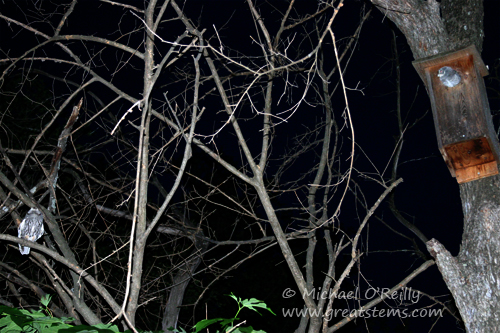
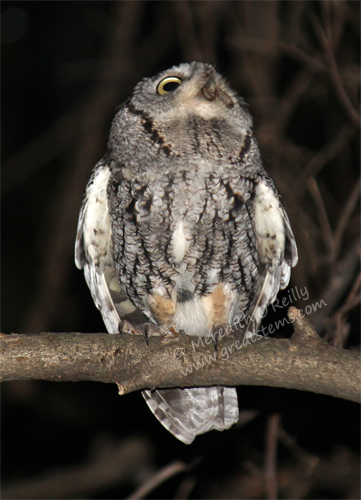 This time, Mama/Papa has brought what appears to be a cutworm. Yum? Well, I suppose cutworms are to baby owls as chocolate is to me.
This time, Mama/Papa has brought what appears to be a cutworm. Yum? Well, I suppose cutworms are to baby owls as chocolate is to me.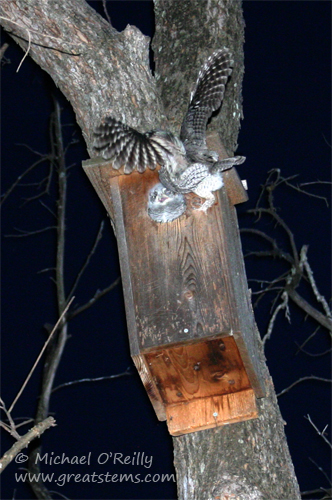
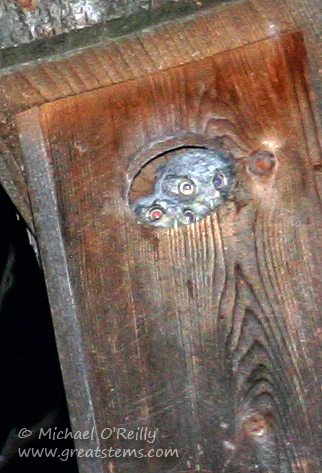
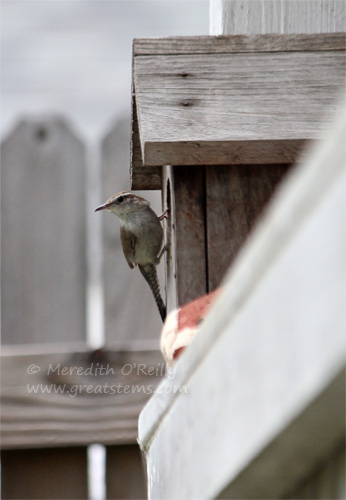 Mama and Papa Bewick’s Wrens, cavity nesters, chose to build their nest in a birdhouse by Kris’ patio this spring. Of course, last year they nested in the pocket of khaki shorts that had been hung out on a laundry line to dry. I guess they decided stability from the wind might be a better bet this time.
Mama and Papa Bewick’s Wrens, cavity nesters, chose to build their nest in a birdhouse by Kris’ patio this spring. Of course, last year they nested in the pocket of khaki shorts that had been hung out on a laundry line to dry. I guess they decided stability from the wind might be a better bet this time.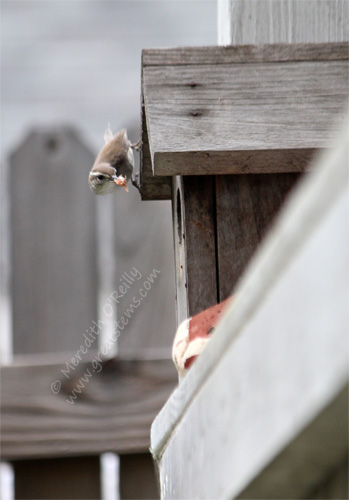
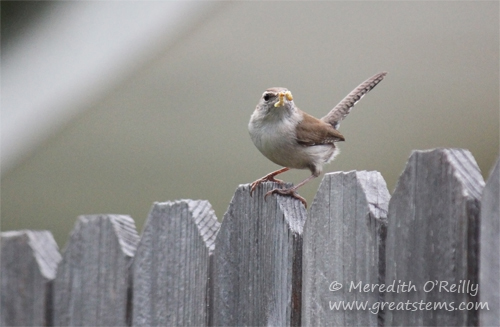
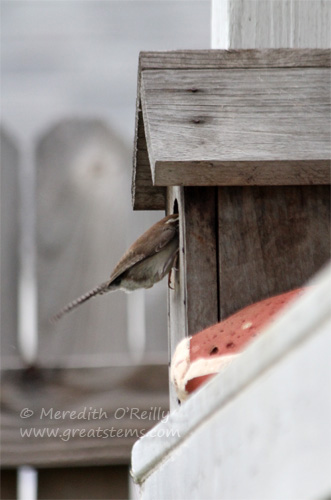
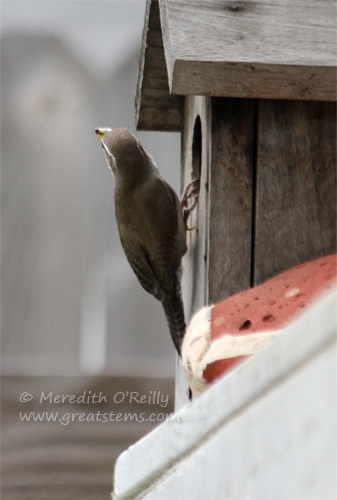 The attentive wren parents also kept a tidy house. Above, one parent can be seen removing a fecal sac. Many baby birds release their poop in a strong mucous membrane, or fecal sac, allowing parent birds to easily pick the membrane up in their bill and remove it from the nest.
The attentive wren parents also kept a tidy house. Above, one parent can be seen removing a fecal sac. Many baby birds release their poop in a strong mucous membrane, or fecal sac, allowing parent birds to easily pick the membrane up in their bill and remove it from the nest.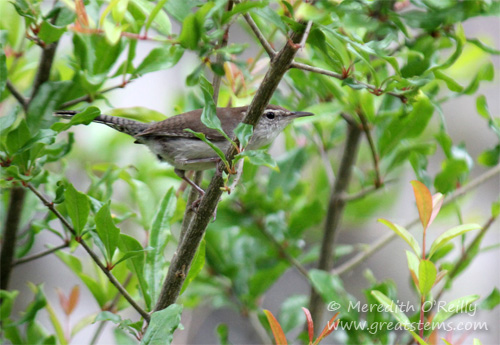 The wren parents always kept a careful eye on the nearby humans, but when they saw we were not a threat, they visited the nest box with regularity.
The wren parents always kept a careful eye on the nearby humans, but when they saw we were not a threat, they visited the nest box with regularity.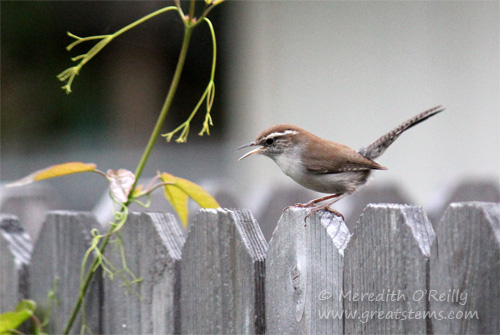 That is, until one woman lingered too long near the nest box, and the returning parent bird in frustration swallowed the insect it was carrying and proceeded to chee-chee-chee-chee angrily at the woman until she left the nest area.
That is, until one woman lingered too long near the nest box, and the returning parent bird in frustration swallowed the insect it was carrying and proceeded to chee-chee-chee-chee angrily at the woman until she left the nest area.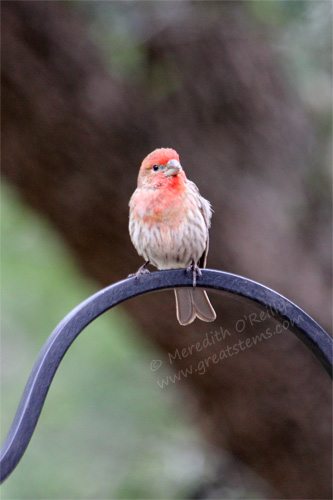 This beautiful male House Finch stood guard for several minutes watching over his mate while she feasted on seeds in a feeder. He’d cock his head this way and that, looking around constantly. He never took time to preen or anything else, though he did sing a little bit (causing me to coo back at him). I was most impressed with how seriously he held watch, and his mate only felt cause to react when the paranoid White-winged Doves on the front side of the fence suddenly flew up en masse — but seeing no concern from her mate, she went right back to eating.
This beautiful male House Finch stood guard for several minutes watching over his mate while she feasted on seeds in a feeder. He’d cock his head this way and that, looking around constantly. He never took time to preen or anything else, though he did sing a little bit (causing me to coo back at him). I was most impressed with how seriously he held watch, and his mate only felt cause to react when the paranoid White-winged Doves on the front side of the fence suddenly flew up en masse — but seeing no concern from her mate, she went right back to eating.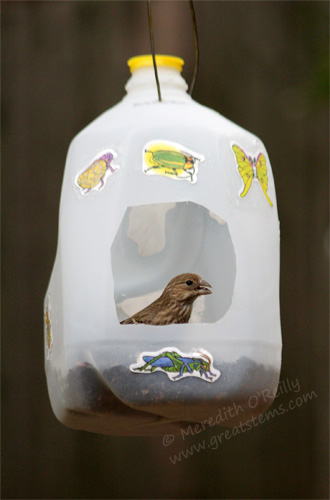 Here the female House Finch just sits inside the milk jug bird feeder, devouring black oil sunflower seeds. We’ve been having fun with kid projects. This is a simple version of a milk jug feeder, decorated only with stickers (held in place with non-toxic outdoor glue) — we have some fancier ones that are going to go out in the garden tomorrow, once the glue dries. On Friday, we’re having a bunch of kids over to make some for their own backyards. Fun!
Here the female House Finch just sits inside the milk jug bird feeder, devouring black oil sunflower seeds. We’ve been having fun with kid projects. This is a simple version of a milk jug feeder, decorated only with stickers (held in place with non-toxic outdoor glue) — we have some fancier ones that are going to go out in the garden tomorrow, once the glue dries. On Friday, we’re having a bunch of kids over to make some for their own backyards. Fun!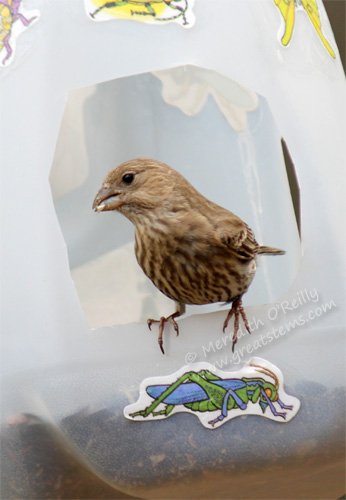
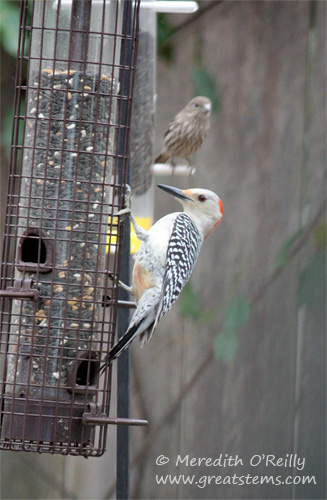
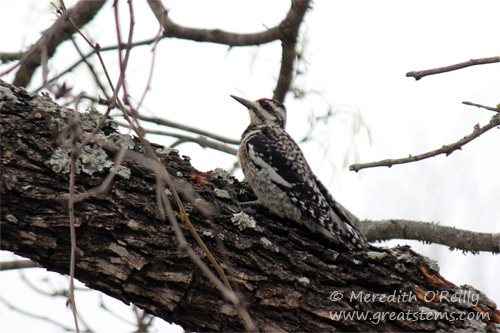
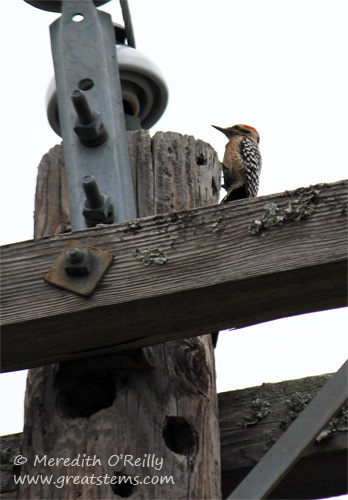
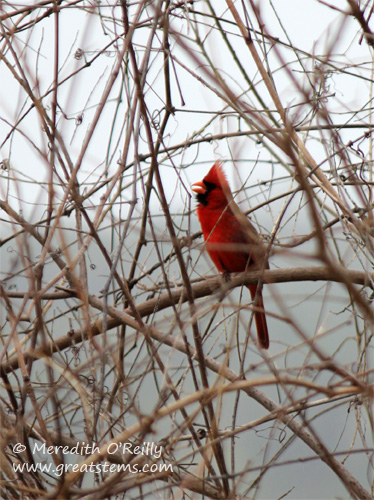 Not to be ignored, this Northern Cardinal was singing his heart out. He and a few other male cardinals were quite feisty today. Gee, does nesting season approach?
Not to be ignored, this Northern Cardinal was singing his heart out. He and a few other male cardinals were quite feisty today. Gee, does nesting season approach?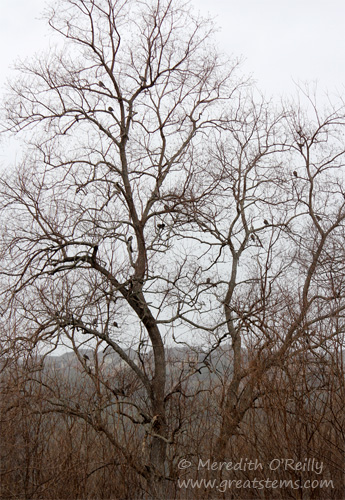
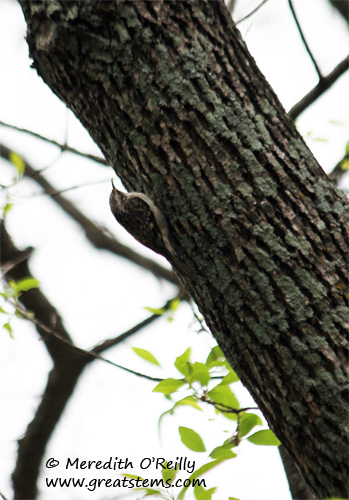
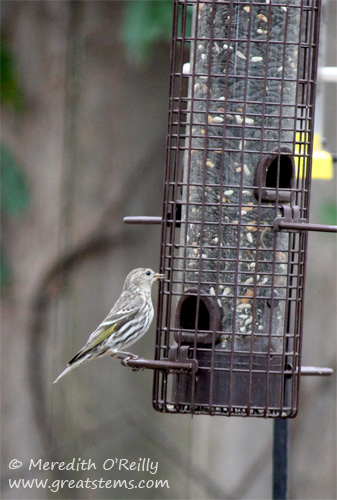
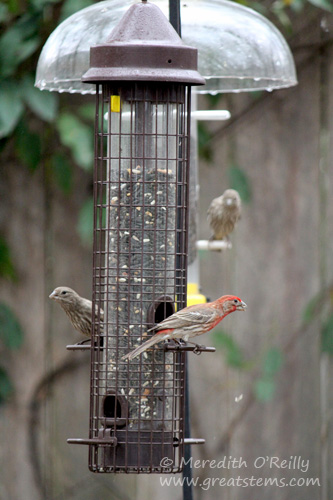
 This weekend the boys and I drove down to Hazel Bazemore Park in Corpus Christi, where hundreds of thousands of hawks and other birds can be seen during peak migration times, especially in the fall. Though fall migration occurs over several weeks, at the end of September local birding groups hold the
This weekend the boys and I drove down to Hazel Bazemore Park in Corpus Christi, where hundreds of thousands of hawks and other birds can be seen during peak migration times, especially in the fall. Though fall migration occurs over several weeks, at the end of September local birding groups hold the  The biggest numbers are usually of Broad-Winged Hawks, though we saw many other raptor species while we were there, including a Zone-tailed Hawk, White-tailed Hawks, and many Kites, Kestrels, and Peregrine Falcons. Due to the heavy rainstorms the day before, however, the numbers weren’t quite as high as might otherwise have been seen — merely thousands as opposed to hundreds of thousands in the overall count.
The biggest numbers are usually of Broad-Winged Hawks, though we saw many other raptor species while we were there, including a Zone-tailed Hawk, White-tailed Hawks, and many Kites, Kestrels, and Peregrine Falcons. Due to the heavy rainstorms the day before, however, the numbers weren’t quite as high as might otherwise have been seen — merely thousands as opposed to hundreds of thousands in the overall count.
 Mine is not a massive zoom lens, mind you, so my hawk pictures are few. However, a stroll around the park let me snap some photos of other birds in the area. Above is a gorgeous Green Jay.
Mine is not a massive zoom lens, mind you, so my hawk pictures are few. However, a stroll around the park let me snap some photos of other birds in the area. Above is a gorgeous Green Jay. One reason Hazel Bazemore is such a top birding spot in the Corpus area is that it offers a variety of habitats to please many different bird species, including shorebirds, as well as birds that prefer denser vegetation.
One reason Hazel Bazemore is such a top birding spot in the Corpus area is that it offers a variety of habitats to please many different bird species, including shorebirds, as well as birds that prefer denser vegetation.






 A European Barn Owl bears quite the resemblance to our native variety but is a bit smaller.
A European Barn Owl bears quite the resemblance to our native variety but is a bit smaller. Here’s an Eagle Owl, which bears a resemblance to our Great Horned Owl but is actually native to Eurasia. It’s also larger than a Great Horned Owl. Gorgeous, it is.
Here’s an Eagle Owl, which bears a resemblance to our Great Horned Owl but is actually native to Eurasia. It’s also larger than a Great Horned Owl. Gorgeous, it is.